Many of Missouri's forest landowners are interested in managing their property for wood products and enhanced wildlife habitat (Figure 1). Fortunately, forest and wildlife management are not only compatible, they are interrelated. Depending on your objectives, you can apply management techniques that influence plant succession and enhance habitats for diverse wildlife species while at the same time improve your forest's productivity. However, managing your property to continually produce timber products and provide wildlife habitat requires an active forest-wildlife management plan.
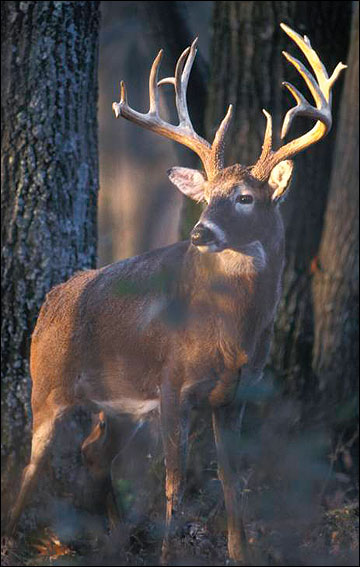
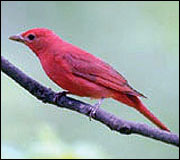
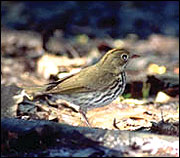
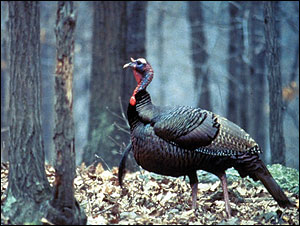
Figure 1
Woodlands and forests provide habitat for a diversity of wildlife species throughout the year.
Develop a management plan
Wildlife habitats can be enhanced through sound timber management strategies. Many timber management practices can be implemented to favor a diversity of trees and plant successional stages — forbs (broad-leaved herbaceous plants), grasses, shrubs, woodlands — that provide wildlife benefits. On average, a private forest landowner in Missouri owns less than 40 acres. Thus, few landowners have the luxury of managing timber stands that accommodate all the needs of species such as migratory songbirds, deer and wild turkey, which use larger areas. So when developing a management plan, you must consider the habitat components available in adjoining stands, the wildlife and timber species most suited to the site, and the habitat needs that aren't being met for the primary wildlife species or group of species for which you are interested in managing your property.
Begin your plan development by conducting an inventory of your property and identifying the vegetative cover types and forest stands that are present. Look for unique geological and vegetative features that should be protected or enhanced. For example, you may want to protect or enhance geological features such as springs, spring seeps and streams, and vegetative features such as den trees, desirable fruit-producing species, snags and glades. An aerial photograph offers a complete look at the land uses and vegetative cover on your property and on adjacent lands. This bird's-eye view can help you understand the potential of your land for supporting wildlife and how you can enhance it. Using an aerial photo, you can identify forest stands, edge habitats, open areas, pastures and water sources, and evaluate their arrangement on your property and surrounding land.
Integrating forest and wildlife management objectives in a management plan will require some compromises. An example of a trade-off would be retaining den trees or snags in the stand rather than removing them to provide additional growing space for crop trees. Another example might be conducting a prescribed burn in a hardwood timber stand to enhance the amount of herbaceous browse for deer at the potential expense of reducing wood quality. Evaluate the costs and benefits within each stand to determine which practices best fit into your overall forest management strategy. A forest and wildlife management plan will help you make trade-off decisions. The plan should take into account your objectives, location of various land cover types and habitats on the property, and the wildlife species in which you are interested.
Table 1 identifies a few timber and wildlife management practices that can be integrated on most forested properties. Most of these practices can be incorporated within the wooded acreage and on surrounding areas of fields for increased timber and wildlife benefits.
All wildlife have four basic requirements for survival: food, water, cover and space. And most wildlife species depend on multiple habitat types. So, managing for plant diversity is important.
Diversity within and between forest stands will influence the diversity of wildlife on a property (Figure 2). Examples of stand diversity include differences in tree density or stocking, tree composition, stand ages, presence of snags and cavities, and the type of disturbance practice conducted. By implementing the appropriate combination of management practices, you can create or maintain different successional stages in your woodland or forest that promote quality stands of timber and a diversity of wildlife species.
Most wildlife species benefit from active forest management. Planned management activities are generally one of your best tools for improving wildlife habitat in woodlands and forests. Some wildlife species benefit from diverse stands of timber and a mix of plant successional stages; others may require large acreages of mature forests.
Wildlife species such as white-tailed deer, cottontail rabbits, eastern wild turkey, indigo buntings, brown thrashers and yellow-breasted chats will benefit from the mix of early successional habitats and shrubby cover that is interspersed with stands of mature forests. Forest management practices can be designed to create diverse stands on the property to benefit these and many other species.
However, forest management practices will also affect the habitat required by other wildlife, such as species of warblers, vireos, wood thrush, ovenbirds and tanagers. These avian species are examples of wildlife that depend on large tracts of forest cover for nesting and foraging. Stands of timber that are highly interspersed or fragmented by other land cover types can create poor conditions for their survival. For instance, research suggests that nesting near edge habitats may be detrimental to some woodland songbirds due to higher concentrations of predators and nest parasites in these areas.
Table 1
General woodland and forest management practices that can benefit wildlife.
| Management practice | Wildlife benefits | Timber management consideration |
|---|---|---|
| Protect forest stand or woodland from grazing. | Increases mast availability; increases stem density for cover; encourages a more diverse understory. | Prevents soil compaction; improves tree vigor and growth; increases regeneration and species diversity. |
| Allow shrubs, vines and soft mast, such as blackberries, to develop along woodland edges. | Increases early successional food and cover for wildlife; transition zone provides increased diversity of plant communities. | Gradual edge reduces wind and drying effects in timber; wood quality is often poor adjacent to edges, so vines and undesirable species have less economic effect. |
| >Allow downed timber or felled trees to remain along the edges of forest stand. | Provides cover and produces insect sources for wildlife. | Returns nutrients to soil and reduces management costs of removal. |
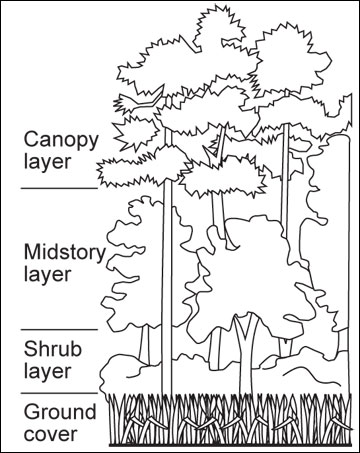 Figure 2
Figure 2
The vertical structure of a forest consists of four layers: the ground-level herbaceous layer of vegetation, the shrub layer, and the midstory and canopy layers provided by various tree species. Some wildlife species, particularly birds, have adapted to using specific layers for foraging and nesting.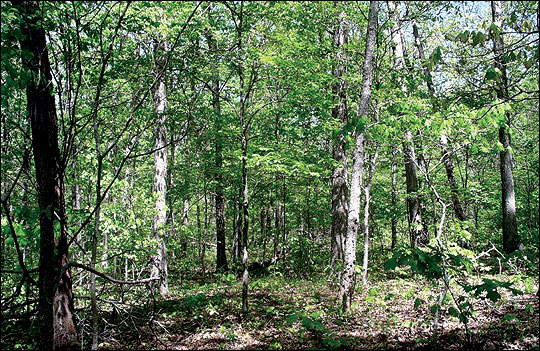
Stages of timber management
Timber management occurs in three stages: regeneration of the stand, intermediate treatments, and harvesting crop trees. The examples in this publication of how to implement each of these stages for timber production and wildlife can guide you in formulating objectives to include in your management plan. When properly planned, each stage can create desirable habitats and enhance the overall value of your woodland.
Decisions that will greatly affect wildlife habitat include
- How the stand will be harvested, which in forestry terminology is commonly referred to as establishing a regeneration cut;
- How you plan to regenerate the stand of trees after the harvest, whether by planting a new stand or harvesting so that the existing stand of timber will regenerate naturally;
- And the type and frequency of any intermediate treatments that might be conducted during the development of the stand, such as forest stand improvements (FSIs), thinning (also called timber stand improvements), or releasing crop trees to improve mast production.
Each of these decisions should be integrated into your plan and will require active management. Different approaches can be taken to manage a stand of trees, depending on the objectives. The regeneration method used will influence the species composition of the new stand of timber. For example, even-aged and group selection regeneration methods are preferred for regenerating hardwoods, as these methods favor mast-producing oaks and other shade-intolerant species. Even-aged methods also promote the lush growth of herbaceous plants and woody vegetation that provide food and cover for many wildlife species.
Regenerating the stand
The purpose of a regeneration cut is to allow planted seedlings or saplings to grow in the understory — that is, beneath the canopy — or within the newly created openings. These young trees will be the future crop trees. You can encourage this regeneration using any of the even-aged or uneven-aged management practices described below. Table 2 describes wildlife benefits that can result from harvesting and regenerating stands of timber using even-aged or uneven-aged management. These practices also may be followed by intermediate treatments that include FSI practices, controlled burns, herbicide treatments, and planting of certain seedling species to achieve the desired results.
Table 2
Timber harvesting practices that can benefit wildlife.
| Harvest practice | Wildlife benefits | Timber management consideration |
|---|---|---|
| Design small regeneration and group selection openings with irregularly shaped borders. | Provides browse, nesting, food and escape cover and increases interspersion of habitat types for diversity. | Regenerates shade-intolerant species such as oak, black cherry and black walnut in a cost-effective manner. (Oaks require advanced regeneration to be present.) |
| When harvesting in strips, clearcut timber in strips that are 60 to 300 feet wide, spaced 600 to 900 feet apart, and perpendicular to the slope. | Provides a continuous supply of browse, food, nesting and escape cover required by diverse wildlife. | Regenerates shade-intolerant species. |
| Perform timber stand improvement and harvest operations in late fall or winter, if possible. | Is less disturbing than other harvest practices to most wildlife; increases sprouting of vegetation the next spring, resulting in excellent cover. | Increases stump sprouting of many species. |
| Establish brush piles near woodland edges or logging roads. | Provides cover for mammals and songbirds. | Enhances cover next to woodland areas that potentially produces the lowest quality timber. |
| Seed permanent logging roads or logging decks and utility right-of-ways with a recommended grass-legume mixture, or allow native vegetation to become established in these areas. | Provides early successional cover for wildlife; increases insect abundance, a food source important to wild turkeys and bobwhite quail. | Prevents soil erosion and maintains these areas for future use. |
Even-aged management
Even-aged management ultimately results in the complete removal of the overstory, or canopy, during a regeneration cut. Three harvest systems that result in an even-aged stand are clearcuts, seed-tree cuts and shelterwood cuts. Harvesting trees using these techniques results in the regeneration of a new stand of trees that are all about the same age.
Clearcuts
Clearcutting is the practice of removing all trees from a tract in a single harvest operation to regenerate the stand of timber (Figure 3). The new stand of trees develops from stump sprouts, a process often referred to as coppice sprouting; from seedlings resulting from an earlier acorn crop; or from planted seedlings. Clearcuts, also known as regeneration cuts, can improve wildlife habitat in several ways:
- Regenerating important mast producing trees, such as oaks, hickories and pines
- Promoting a lush growth of early successional vegetation
- Creating a diversity of habitats for a wide variety of wildlife, when the regeneration cuts are mixed with timber stands of different ages
Clearcutting may be the best way to improve a stand that is dominated by less than desirable tree species. Den trees and snags can also be marked before the harvest and left on the site to provide wildlife benefits. In most cases, areas can be harvested to create a patchwork and diversity of plant successional stages, particularly if the property is located in an area that is dominated by large areas of forest. The openings that are created favor the regeneration of desirable mast trees, such as oaks and hickories. If you do not wish to cut an entire stand, harvesting 2- to 10-acre patches on a 10- to 20-year rotation will result in an increase in browse — the leaves, twigs and shoots that many animals feed on — and creates habitat for wildlife species requiring early successional stages while still providing areas for regeneration of shade-intolerant tree species.
Regeneration cuts create areas that are abundant in herbaceous growth, young woody stems and advanced regeneration of saplings, which provide food and cover for deer and other herbivores such as cottontail rabbits, mice, voles and woodchucks. The resulting dense cover also provides habitats for a variety of birds, including American woodcocks, ruffed grouse, yellow-breasted chats, indigo buntings, brown thrashers and blue-winged warblers. As these young stands regenerate and begin to mature, they go through a period, when they are 25 to 40 years old, during which herbaceous forage and browse are no longer available and hard-mast production has not yet begun. During this period, several required habitat components are not present in the stand unless FSI and thinning are practiced. These intermediate treatments are described in greater detail below.
 Figure 3
Figure 3
Clearcutting allows for a new crop of trees that are the same age to be regenerated in the stand. The vegetation growth that occurs provides excellent browse and cover for many wildlife species, including white-tailed deer.
Seed-tree and shelterwood harvest
The seed-tree and shelterwood systems both leave crop trees scattered throughout the area to provide a source of seed for the next stand. Generally, leaving about 10 to 15 seed trees per acre can regenerate the stand using a seed-tree cut technique. The shelterwood technique leaves more crop trees standing after a harvest. Both techniques allow for more sunlight to reach the forest floor, stimulating the germination of annual plants and new growth of browse. The open conditions also create a favorable environment for oaks and other shade intolerant species to grow and successfully compete within the stand.
Uneven-aged management
Harvesting trees using an uneven-aged management system results in a stand of trees of many ages and sizes. Typically, few trees are harvested at any one time, thus the stand usually has several layers of vegetation that make up the tree canopy, which shades the forest floor. This lack of sunlight tends to favor shade-tolerant species, such as maple, hornbeam, elm and dogwood. An uneven-aged management system is often recommended for landowners that own relatively small tracts of timber. Uneven-aged management can also provide steady, periodic income. Two harvest systems that result in an uneven-aged stand are single-tree selection and group selection.
Single-tree selection
Single-tree selection creates a stand of trees that are different ages and sizes. This technique does not produce as many seedlings for regeneration as a clearcut, but instead promotes the recruitment of high-quality individual trees into the stand while maintaining an uneven-aged forest. One approach that has been used successfully is to remove trees that are of lower quality, due to form or disease, that compete with nearby higher-quality crop trees for the purpose of retaining better growing stock on the site over a longer period.
Group selection
In a group selection system, small groups of trees are harvested, creating regeneration openings within the stand (Figure 4). These openings are essentially small clearcuts, usually about half an acre. Harvesting small groups of trees allows more sunlight to reach the forest floor, encouraging the growth of early successional vegetation and resulting in an increased abundance of sprouts, shrubs, grasses and herbaceous vegetation. These openings also stimulate the regeneration of shade-intolerant mast-producing tree species, such as oak, hickory and black cherry. A dense growth of other woody plants will also flourish in these openings, such as dogwood, serviceberry and viburnums. These species provide a diverse food source for many wildlife, and the shrubby understory structure is preferred by many bird and mammal species, such as summer tanagers, indigo buntings, yellow-breasted chats and cottontail rabbits.
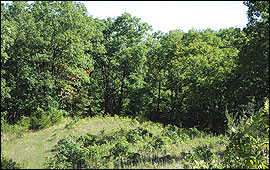

Figure 4
Small group openings within the forest can benefit many wildlife species and also promote the regeneration of shade-intolerant trees, such as species of oak.
Intermediate management considerations for wildlife benefits
Several intermediate management practices can be conducted to enhance wildlife habitats while improving the growth of individual trees in the stand. Table 3 provides a summary of the wildlife benefits that can result from conducting specific FSI practices on your property.
Table 3
Forest stand improvement (FSI) practices that benefit wildlife.
| FSI practice | Wildlife benefits |
|---|---|
| Retain cavity trees within 50 feet of woods' edge, where timber quality is lowest, and in wetlands beside streams, where harvest is difficult or not recommended. | Provides den and nest sites for wildlife such as wood ducks, squirrels, raccoons and woodpeckers. |
| Encourage a mix of mast-producing trees, such as red and white oaks, hickory, black walnut, black cherry and blackgum. | Provides food for wildlife. |
| Girdle unsalable trees that should be culled from the stand; leave standing dead trees as snags. | Creates small openings that benefit early successional vegetation; snags provide food sources for insect-eating birds, such as woodpeckers and nuthatches. |
Conducting forest stand improvement and thinning practices
Forest stand improvement (FSI) is an intermediate treatment in the regeneration of a forest stand. Treatments are made to improve the composition, structure, condition, health and growth of a stand of timber (Figure 5). FSI can be implemented to increase a woodland's potential for providing valuable timber products and to improve forage production and wildlife habitat.
Thinning a stand of timber is a FSI practice that involves removing undesirable trees that are competing with more desirable crop trees, such as pines, oaks and hickories (Figure 6). Thinning gives the desirable trees more space to grow. It can also improve the growth of trees in the stand and allow more sunlight to reach the understory, thus increasing the amount of browse and forage available (Figure 7).
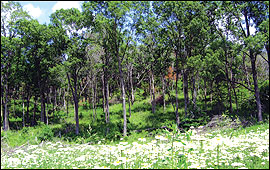

Figure 5
A variety of intermediate treatments, including FSI and thinning practices, can be implemented to improve timber quality and enhance the habitat for various wildlife. Prescribed fire can also be used as an intermediate treatment in certain stands to enhance the growth of herbaceous browse and annual plants that benefit various wildlife species.
 Figure 6
Figure 6
Thinning a stand of timber, such as this stand of short-leaf pine, can improve the growth of the remaining trees as well as enhance the availability of forage and browse for wildlife.
 Figure 7
Figure 7
The closed canopy of trees on the left that has little herbaceous vegetation at the ground layer. The stand on the right has been thinned, resulting in an understory with diverse vegetation on the ground layer that provides abundant forage and cover for wildlife.
Retaining den trees and snags
Some trees are more valuable dead than alive. Missouri has 89 wildlife species that require snags and den trees for nesting, feeding and shelter (Figure 8). Snags are standing dead trees; den trees are live trees with a hollow cavity. Another group of species depends on fallen woody debris such as rotting logs, limbs and brush piles. Therefore, your management plan should include retaining decaying and dead standing trees and downed wood in the stand.
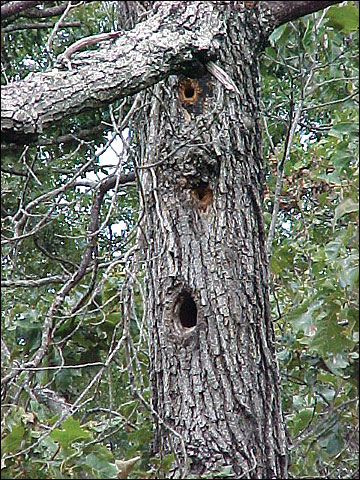
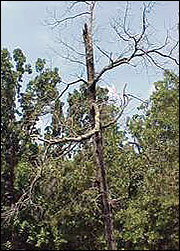 Figure 8
Figure 8
Den trees (left) provide wildlife with nesting sites and cover. When conducting a forest stand improvement or timber harvest, mark snags (right) and den trees to be left on the site.
Snags
Leave or create one snag larger than 20 inches in diameter at breast height (dbh) (4.5 feet above the ground) per acre for use by species such as pileated and red-headed woodpeckers and gray squirrels. Leaving two snags between 6 and 10 inches dbh per acre is beneficial for species such as black-capped chickadees and, near field edges, for eastern bluebirds. You can create these habitats by deadening select unsalable trees by girdling the tree with a chain saw and applying an approved herbicide. Always read and follow chemical labels for proper rates, usage and disposal.
Den trees
Leave or establish one den tree larger than 20 inches dbh per acre for such species as barred owls, fox squirrels and raccoons. Additional den trees that are greater than 10 inches dbh will benefit gray squirrels, tufted titmice, red-breasted nuthatches and house wrens. Do not remove den trees during regeneration cuts or when conducting FSI.
Conducting a prescribed fire
A prescribed fire, or controlled burn, can be a useful practice for enhancing wildlife habitats in certain plant communities, including in pine and hardwood forests and woodlands. Fire is an important management tool that can be used to create open woodlands, or savanna habitats. Fire sets back plant succession and promotes the growth of herbaceous annual plants, weeds and forbs. However, if a prescribed fire is planned in a stand of hardwoods where the overall objective is to grow high-quality trees, the burn should be performed within about five years before harvest.
Prescribed fires should be planned to accomplish very specific management objectives, so it is extremely important to seek advice from natural resource professionals with the Missouri Department of Conservation (MDC) or MU Extension. They can help you develop a burn plan so that the fire is conducted safely and under exact weather and fuel conditions to accomplish your objectives and the desired changes in vegetation.
Harvests
Numerous recommendations can be incorporated into timber harvests to benefit wildlife (Table 2). With the exception of some songbirds, which may be sensitive to edge habitats, most wildlife species found in woodlands and forested habitats require openings, edges or early successional stages of forest cover to fulfill some of their habitat requirements. An efficient way to manage for these species is to create their desired habitat component through a commercial timber harvest. Selling the timber makes the cost of managing for wildlife affordable by providing some income from your investment.
In addition, you should protect unique or important habitats by keeping tree harvests at least 100 feet from habitats such as small ponds, temporary pools, rocky outcrops, springs and seeps. Streams that flow or have large pools of water throughout the year should be protected from tree harvests by maintaining a buffer of at least 50 to 100 feet along each side. This buffer is referred to as the riparian area. The MDC's best management practices specify and recommend harvesting practices that can voluntarily be conducted within riparian areas. (Refer to the Missouri Watershed Protection Practice handbook listed under Additional resources.)
Management practices that enhance habitats at the forest and field edge
Edge habitats are the transition zones between two different plant communities, such as within a stand of timber where disturbances have occurred or between a stand of timber and a crop field or pasture. Many wildlife species depend on the diversity of vegetation that grows in these transition zones. Forest edges are edge habitats that occur within the forest, and nonforest edges are those that occur where there is a distinct break between forests and nonforest cover types, such as agricultural fields, subdivisions, urban areas, and pastures. Each edge type provides unique habitat components that a variety of wildlife will use during the year.
A forest edge is created when a woodland road, a logging deck or a regeneration or group selection cut is made within a stand of timber. Tornadoes, high winds and fire are natural events that can also facilitate the development of this type of edge habitat. Forest edges are typically evident for only a short time, from five to 15 years. As plant succession advances and the regeneration trees grow larger, a forest edge disappears. However, disturbances in the forest will encourage the growth of a variety of trees of different ages, heights and densities, providing structural diversity within the stand and enhancing nesting and foraging habitats for a variety of wildlife species. These disturbances are important because nearly 70 percent of the 260 wildlife species occurring within the central U.S. hardwood forest region require successional stages that are less than 40 years old to meet at least part of their habitat requirements.
Nonforest edge can be enhanced through a variety of management practices, such as edge feathering, developing brush piles, hinge-cutting or establishing field borders between tracts of timber and other fields. All too often, these locations consist of an abrupt or "hard" edge, with little or no transition between habitat types (Figure 9). The practices described below can create a "softer" or tapered transition zone to promote increased plant diversity between stands (Figure 10).
The management of field edges can enhance the growth of succulent vegetation and fruits beneficial for bobwhite quail, deer, turkeys and many species of songbirds that require shrubby cover for nesting and escape. Examples of beneficial shrubs that occur in these areas include wild plum, blackberry, persimmon, hawthorns, dogwoods, red buds, sumacs, serviceberry, elderberry and crabapples. In addition, greenbriers, poison ivy, buck brush and annual seed-producing plants such as legumes may also be increased as a result of these management practices.
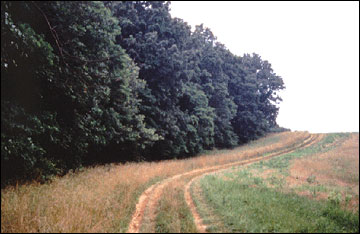 Figure 9
Figure 9
The "hard" edge between this timber stand and pasture could be "softened" through management practices such as edge feathering or creating brush piles and field borders to improve habitat conditions for a diversity of wildlife.
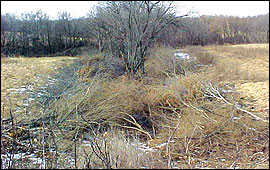
 Figure 10
Figure 10
A nonforested edge can be improved for wildlife by edge feathering and improving the transition zone between fields.
Edge feathering
Edge feathering creates a gradual transition zone between forested tracts and open fields. This zone can be managed for grasses and legumes that are beneficial to wildlife, as well as for shrubby cover.
- Cut select large, unsalable trees within 30 feet of the woody edge. Treat stumps with an approved herbicide. Leave native shrubs such as wild plum, dogwood and sumac along these edges. You can drop trees and let them lie, cut the logs for firewood, or build brush piles that can provide additional cover for bobwhite quail and rabbits.
- Edge feather areas at least 50 feet long and spaced at least every 300 feet along the edges of the field.
- Before conducting this practice, be sure to kill any sod-forming grasses, such as tall fescue, under the canopy with an approved herbicide. Removing these grasses will ensure that annual weeds and shrubs will be able to grow — and will provide access to this cover for species such as bobwhite quail.
Providing brush piles and downed-tree structures
Brush piles provide a place for select wildlife species — such as small mammals, cottontail rabbits, ground-nesting birds, reptiles and amphibians — to escape from predators. Proper construction and placement is extremely important. Brush piles should be at least 6 to 8 feet tall and wide. They can be created using limbs and other debris from trees and brush that were cut during a FSI (Figure 11). Place brush piles in strategic locations near food sources along field borders or in locations near other types of escape cover.
Downed-tree structures can also provide a temporary source of woody cover in areas where shrubs are lacking (Figure 12). These structures are sometimes called living brush piles — if the small trees are cut part way so that the top falls to the ground, a technique called hinge-cutting. This type of cover can be quickly created by cutting several trees to fall in a crisscross pattern over each other.
- Downed-tree structures can be used to complement the creation of brush piles and located in areas that will be managed for permanent shrubby cover, such as bobwhite quail covey headquarters. These areas can provide temporary cover until the planted or managed shrubs become available. Create this type of cover at intervals of every 5 acres or 200 feet along the forest-field border.
- Place at least three downed trees in each structure.
- Don't push downed trees into dense piles, but instead place them in a loose arrangement so that areas of bare ground are available to promote wildlife access.
- Place these structures in areas where herbaceous vegetation, such as tall fescue, is controlled.
- Oak, hickory or cedar make excellent downed-tree structures that provide escape cover for many wildlife species.
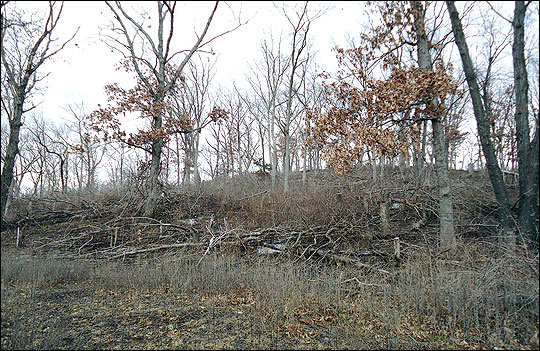 Figure 11
Figure 11
Brush piles created near field edges and in other strategic locations provide escape cover for many wildlife species.
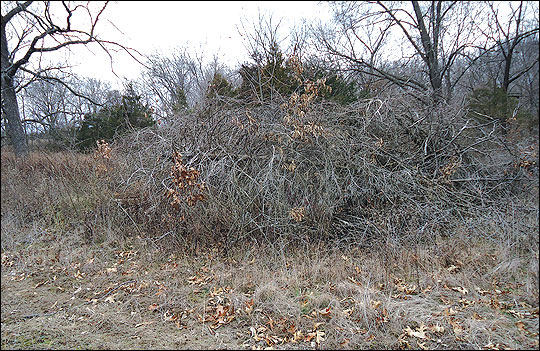 Figure 12
Figure 12
Hinge-cut trees and other types of downed-tree structures created near field edges provide escape cover for wildlife.
Managing for shrubs (covey headquarters)
Shrubs provide important food and cover plants that are highly desired by bobwhite quail, cottontail rabbits and many species of songbirds. Patches of thickets and shrubby cover along the edge of fields and within fields can be managed for wildlife and are very valuable to them, particularly as this type of cover is often in short supply on many farms (Figure 13). Edge feathering, brush piles and downed-tree structures can be used to create this vegetative and structural diversity on a temporary basis, but shrubs may need to be planted to achieve more long-term benefits.
- Place a mixture of shrubs — which may include blackberry, sumac, dogwood and wild plum — around or within fields that are lacking this cover type. The mix of species provides vegetative diversity.
- Plant shrubs around brush piles or downed-tree structures, or in other strategic locations, on a 5-by-5-foot spacing.
- Be sure to kill sod-forming grasses, such as tall fescue, that may be growing in these areas, so that annual weeds and forbs can become established.
 Figure 13
Figure 13
Patches of shrubs adjacent to fields and timber stands provide excellent escape cover for wildlife and are a habitat component that is often in short supply on farms in Missouri. 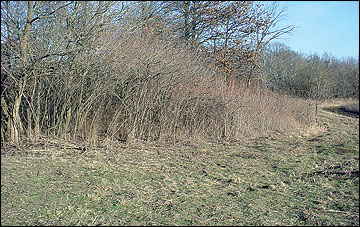
Establishing a field border between a woodland edge and a crop field
In areas where wooded land is adjacent to a crop field, both edge feathering and field border establishment can be very beneficial for wildlife. Field borders composed of native warm-season grasses, forbs and legumes can provide important habitats for wildlife such as bobwhite quail, cottontail rabbits and songbirds. These areas provide for the creation of wider transition zones between crop fields or between fields and woodlands or a stream (Figure 14).
- Establish a 30- to 50-foot-wide border along the edge of the crop field.
- Either plant the border with recommended grass-forb mixtures or allow the border to grow fallow.
- Refer to MU Extension publication G9421, Field Borders for Agronomic, Economic and Wildlife Benefits, for additional information on establishing and managing field borders beside forested habitats and crop fields for wildlife benefits.
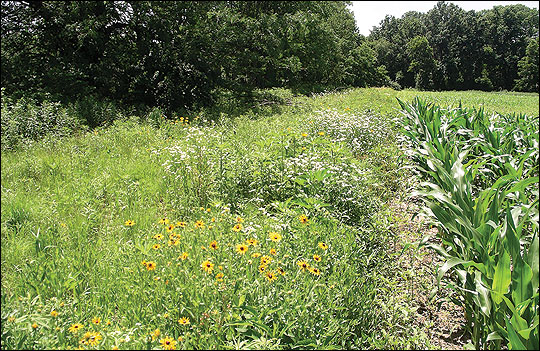 Figure 14
Figure 14
Field borders of native warm-season grasses, forbs and legumes created between crop fields and woodlands provide vegetative diversity and habitat benefits for many wildlife species.
Enhancing other areas of your property for wildlife
In addition to woodlands and forests, your property may be composed of habitats such as croplands, pastures and grasslands. Each of these areas can potentially be improved for a variety of wildlife. Table 4 provides information on wildlife management activities that can be conducted on a property regardless of how the land is being used.
Table 4
Wildlife habitat improvement practices that can be implemented in addition to forest management.
| Management practice | Wildlife benefits |
|---|---|
| Plant small (1- to 5-acre) food plots, or leave small portion of adjacent crop fields unharvested. | Provides food in areas where natural sources are limited. |
| Plant or encourage shrubs next to forested edge, and favor trees, shrubs and fruits of high value to wildlife, such as dogwood plum, hawthorn, crabapple, sumac and sassafras. | Provides food, cover and nesting habitats. |
| Erect nest boxes for cavity-nesting species — such as wood ducks, bluebirds and squirrels — where natural cavities are not found. | Provides cover and nesting sites; advances succession in areas with no natural cavities or little timber; is a good option if retention of trees with cavities is inconsistent with timber objectives. |
| Protect den trees. | Provides cover and nesting sites for birds and mammals that use cavities. |
| Establish trees, shrubs and permanent cover crops in areas not suited for farming. | Prevents soil erosion and provides additional sources of food and cover. |
| Establish and maintain openings in or beside large continuous tracts of mature timber. | Provides early successional vegetation, which many wildlife species require. |
| Replace tall fescue with mixtures of native warm-season grasses and native forbs. | Creates structural diversity and increases food availability for a variety of birds and mammals. |
| Establish field borders with native forbs, grasses and legumes along woodland edges. | Provides nesting and brood-rearing cover that is close to escape cover. |
Conclusion
With proper planning, woodlands and forests on your property can be managed to provide habitats for wildlife and to produce timber. Enhancing wildlife habitat on your property can be a rewarding experience. One of the first steps to take is to develop a forest-wildlife management plan to help guide your decisions. Many options and trade-offs need to be considered, and having a plan in place will help you identify tasks that need to be conducted to ensure that your overall management objectives will be accomplished. Professional foresters and wildlife biologists are available to help determine a woodland's potentials and limitations and to help develop and carry out a suitable management plan. Be sure to take advantage of the educational resources and technical assistance provided by the resource professionals with the Missouri Department of Conservation, U.S. Department of Agriculture Natural Resource Conservation Service and MU Extension in your area of the state.
Additional information
In addition to the MU Extension publications listed on page 10, the following publications provide more information about managing your land for wood products and wildlife:
- Missouri Department of Conservation. 2014. Missouri watershed protection practice. Jefferson City: Missouri Department of Conservation. Missouri Watershed Protection Practice (PDF).
- Thompson, Frank R. III, and Daniel R. Dessecker. 1997. Management of early successional communities in central hardwood forests — with special emphasis on the ecology and management of oaks, ruffed grouse and forest songbirds. http://www.nrs.fs.fed.us/pubs/gtr/gtr_nc195.pdf.